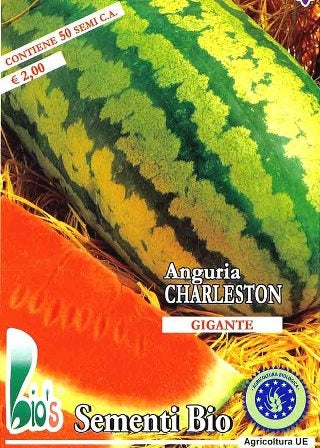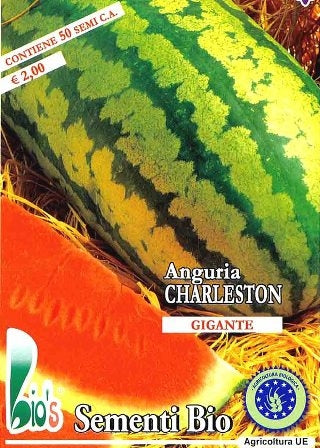Brief history and botanical notes on the plant
Called watermelon in the northern regions and watermelon or water melon in the southern regions, it is a plant native to tropical Africa.
It was already known by the ancient Egyptians who cultivated it along the Nile. It was subsequently introduced into the Mediterranean basin and spread to our country at the beginning of the Christian era.
Today it is widely spread throughout the world, both in the tropical and warm-temperate zones, due to its very large fruits filled with a very watery, sweet and refreshing pulp.
At a global level, watermelon cultivation affects 1 million and 500,000 hectares and in Italy it is widespread and is grown in open fields or in mulched crops on more than 18,000 hectares.

Botanical characteristics
Annual herbaceous plant consisting of a stem that rapidly branches into other creeping stems on the ground, up to a few meters long, equipped with tendrils.
The leaves are scattered, large with a widely lobed edge, olive green in colour.
The roots are very developed especially on the surface but also in depth.
Normally the watermelon plant is monoecious, that is, it bears separate male and female flowers, although there are cases of andromonoecious varieties with male flowers and fertile hermaphroditic flowers on the same plant.
Male flowers appear first and outnumber female flowers by a ratio of 7:1.
For the success of the crop, pollination is fundamental and occurs entomophilously (bees and pollinating insects). Allogamy is the rule, 40-50 days after fertilization the fruits reach complete maturation.
The fruit of the watermelon is a peponid whose epicarp, mesocarp and endocarp are welded together, in which we can distinguish the "peel", externally smooth and leathery, and the "pulp" which completely fills the fruit in which numerous flattened seeds are immersed, weighing 35-100 mg.
In some countries these seeds are salted, toasted and consumed as a "snack". The appearance, shape and size of the fruits are highly variable with the variety and cultivation conditions: the weight of a fruit varies from 2 to 15 kg, the shape is spherical or elongated, the external color is light green, dark green or with streaks of both colours, the pulp is generally red, but there are also types with yellow or white pulp.
Climatic and environmental needs
Watermelon has very high thermal requirements: the minimum germination temperature is 15°C, which requires it to be sown only in late spring (April-May) to be harvested in midsummer. Since early production has a very high economic value, watermelon is often grown in the field in semi-forced cultivation: the simplest form of forcing is mulching the soil with plastic film, a more intensive form involves, in addition to mulching, covering the rows with small tunnels also made of plastic film. The thermal effect of these covers in the first weeks of growth allows the start of the harvest to be brought forward by several days and makes it a true first-fruit.
Given the low rainfall during the growing season, irrigation is almost always essential. The most suitable soils for watermelon are fertile, deep and loose, either for texture or for excellent structure.
Varietal characteristics
The characteristics that define the value of a variety of watermelon are:
– precociousness,
– sugar content,
– size that meets market needs,
– resistance to transport and storage,
– resistance to diseases (Fusarium and Anthracnose, distinguished by the acronyms F and A),
– uniformity and productivity.
– The most cultivated varieties in Italy are the Sugar Baby and the Crimson Sweet, the forty or fifty and the Pistoia and Faenza watermelon are excellent.
Fertilization
The needs that fertilization with compost must provide in nitrogen are very high: from 100 to 170 Kg/ha, in phosphorus from 80-100 Kg/ha of P2O5 and in potassium from 100-130 Kg/ha of K2O.
Cultivation techniques
Watermelon is a good renewal crop which, however, should not return to the same soil before 5 years to reduce the risk of parasitic attacks. The planting is done with direct sowing in the field or with transplanting of seedlings grown in phytocella, the first method is the one that is adopted both for open field cultivation and for forced cultivation, the second only for forced cultivation to further anticipate the time of harvest.
A widely used sowing system is to sow 4-5 seeds close together and then thin out the resulting seedlings, leaving 2 for each post.
It requires excellent workmanship, disking to be carried out in time in clayey soils, and good refinement of the soil with harrows.
Distances and layouts
Given the shape and length of the stems, the planting spacing is quite wide: very common for traditional varieties with large growth is 2-3 m between the rows and 1.5-2 m between the posts, in order to achieve a density of 0.3-0.5 plants per square meter, with new varieties with rather small fruit the density can be somewhat higher, achieved, for example, by spacing the stands 1 meter by 1 meter apart.
In the case of mulched crops, the transparent plastic film is spread after sowing and, when the time has come, thinning is carried out through cuts appropriately made on the film.
The quantity of seed required is 3-5 kg/ha.
Weed control in open field crops is done with repeated weeding as long as the development of the crop allows it.
In the case of mulching with transparent film, weeding must be repeated several times before applying the covering.
When you reach the fourth leaf, you use to trim the shoot to encourage the emission of axillary jets from which to obtain more fruits which, in any case, should not be more than 3 or maximum 4 per plant. Beyond this number it is advisable to thin them out.
When the cost of labor allows it, the fruits that have reached approximately one kilo of weight are raised from direct contact with the ground by placing straw between them and the ground, furthermore, to obtain fruit with a more regular shape and more uniform ripening. , it is customary to rotate them periodically.
For this crop, irrigation cannot be ignored, especially when the watermelon has been transplanted (due to the shallower depth of its root system).
The maximum water requirement occurs when the flowers set until the fruit swells. Two weeks before harvesting, irrigation should be suspended to encourage the concentration of sugars in the fruits.
In the case of mulched crops, irrigation is done using perforated hoses or drip lines which are placed on the ground before spreading the cover.
Production and collection
The fruits are ready for harvesting approximately 4 months after sowing, particular attention must be paid in identifying the signs of ripening (indeed not very evident to non-experts) so as not to harvest immature watermelons. The most evident symptoms on the fruit are: drying of the peduncle and the cirrus that accompanies it, a dull and dull sound upon percussion, total disappearance of the bloom that covers the immature fruit.
Defense and parasites
The diseases that attack the watermelon plant are numerous; the most harmful ones are some mycoses including downy mildew (Peronospora cubensis), anthracnose (Colletotrichum orbiculare), tracheofusarium infections (Fusarium spp.) and the Pythium genus. The defense is implemented with preventive treatments of horsetail and with cupric products in the youthful stages of growth. Attacks by harmful parasitic insects are rarer.
Biodynamics
With this very demanding crop, particular attention must be paid to fertilization by preparing large quantities of vegetable compost and manure in the previous year, introducing the preparations from the heap 2 successive times and having a variable maturation from 8 months to a year.
Use corn manure at sowing and again after 2 weeks. Cornsilica at the formation of the fruits and when they begin to swell, approximately two weeks before harvesting



